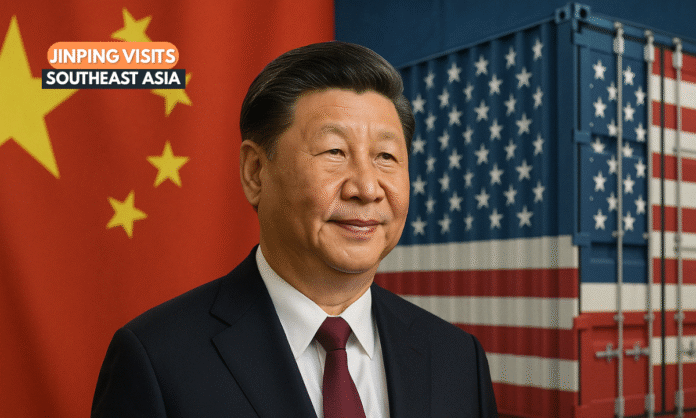SUMMARY
- Xi Jinping begins 3-nation tour as US slaps tariffs up to 145% on Chinese goods, sending global markets into a tailspin.
- China pledges deeper trade ties with Southeast Asia amid US demands to halt transshipments from China.
- Vietnam and other ASEAN nations fear being collateral damage as they walk a tightrope between Beijing’s investment clout and Washington’s trade pressure.
Trade War Fallout: Xi Jinping Races to Reinforce China’s Southeast Asia Frontline
Chinese President Xi Jinping has launched his first foreign visit of 2025, beginning in Vietnam and moving through Malaysia and Cambodia, with a clear message: China is the guardian of global trade, not the US. His timing is crucial. Just days before, the Biden administration announced sweeping new tariffs of up to 145% on Chinese imports, shaking already-volatile global markets and reviving fears of deepening decoupling between the world’s two largest economies.
In an op-ed published in Vietnamese media ahead of his visit, Xi warned, “Protectionism will lead nowhere,” adding that trade wars produce no winners. With his trip, Xi aims to solidify China’s image as a stable, open, and cooperative alternative—especially as Southeast Asian countries like Vietnam and Malaysia become new manufacturing hotspots due to shifting supply chains away from China.
Yet, that shift has not shielded them from tariff pain. Several nations now face levies of up to 49% on exports to the US. Southeast Asia’s emerging economies now find themselves at a critical inflection point: continue aligning with China’s capital and infrastructure, or yield to US trade pressures and compliance demands.
President Xi Jinping's just-concluded Southeast Asia tour focused on good-neighborly relations and promoted mutually beneficial cooperation, and achieved a complete success, Chinese Foreign Minister Wang Yi said on Friday. #XiJinping #习近平 #XiVisit @XisMoments… pic.twitter.com/zzzvDaQMR9
— China Daily (@ChinaDaily) April 19, 2025
Xi’s Tour Strategy: Cushion Southeast Asia, Counter Washington
- Xi began his tour in Vietnam, a top manufacturing hub facing a 46% US tariff rate.
- He will visit Malaysia, ASEAN’s 2025 chair, and Cambodia, a Chinese ally and transit point.
- The message: China stands by free trade, opposes protectionism, and welcomes regional cooperation.
Xi’s visit is more than symbolic. It is an assertive diplomatic counterstrike to Washington’s tariff escalation and its demand that countries like Vietnam and Cambodia crack down on transshipment of Chinese goods.
Xi’s meetings with regional leaders will likely include infrastructure deals, trade expansion pacts, and pledges to support local development, all aimed at presenting China as a more reliable and less transactional partner than the US.
According to analysts, China is attempting to cement ASEAN as a stable economic buffer zone while promoting a “multi-polar world order”—code for resisting US-led unipolar dominance.
America’s Dilemma: Can It Contain China Without Alienating ASEAN?
- Trump’s trade adviser Peter Navarro publicly demanded Southeast Asian nations stop enabling tariff evasion via Chinese transshipments.
- US Treasury Secretary Scott Bessent has begun formal trade talks with Vietnam to limit its role as a Chinese proxy in export chains.
- Washington fears that bypassing China via ASEAN weakens tariffs and emboldens Beijing.
The US is now walking a diplomatic tightrope. While trying to contain China’s global manufacturing dominance, it must also recruit Southeast Asian nations as trade partners—a nearly impossible balance.
“One big ask, said political analyst Yanmei Xie, is for countries like Vietnam and Cambodia to decouple further from China in exchange for more access to the US market.”
But that’s easier said than done. China remains ASEAN’s top trade partner, and its infrastructure spending through initiatives like the Belt and Road continues to outpace American investment by wide margins.
Risks and Rewards for Southeast Asia: Growth vs Geopolitical Gamble
- Vietnam has seen its GDP growth forecast drop from 6.2% to 5% due to the new US tariffs.
- ASEAN nations fear economic squeeze as global trade gets politicized.
- Southeast Asia continues to be a transit hub and battleground for the US-China power rivalry.
The pressure on Southeast Asian economies is immense. While Vietnam has benefited from the manufacturing exodus from China, it now faces tariffs that could choke its exports. Likewise, Singapore’s foreign minister warned that the unraveling global trade order could be “hostile to small nations”.
Despite close economic ties, regional governments remain wary of China’s intentions. While they welcome Chinese investments, they fear becoming economically dependent or politically manipulated. James Char, a researcher from Singapore’s S. Rajaratnam School, put it succinctly: “Most Southeast Asian countries have reservations about China as a magnanimous hegemon.”
What’s Next: A Split World Order or a New Equilibrium?
Xi’s tour underscores a new Cold War of economic influence, where trade agreements and infrastructure projects become tools of diplomacy. As Trump and Biden escalate tariffs, and China deepens ties with neighboring economies, the global order is increasingly defined by which camp countries choose—or how long they can remain neutral.
With EU leaders expected to visit China in July and a slew of bilateral talks underway, ASEAN may become the chessboard where 21st-century global alliances are redrawn. For now, Xi’s charm offensive is in full swing—but whether his promises of “openness” resonate more than Washington’s pressure will depend on how each nation balances prosperity with sovereignty.


